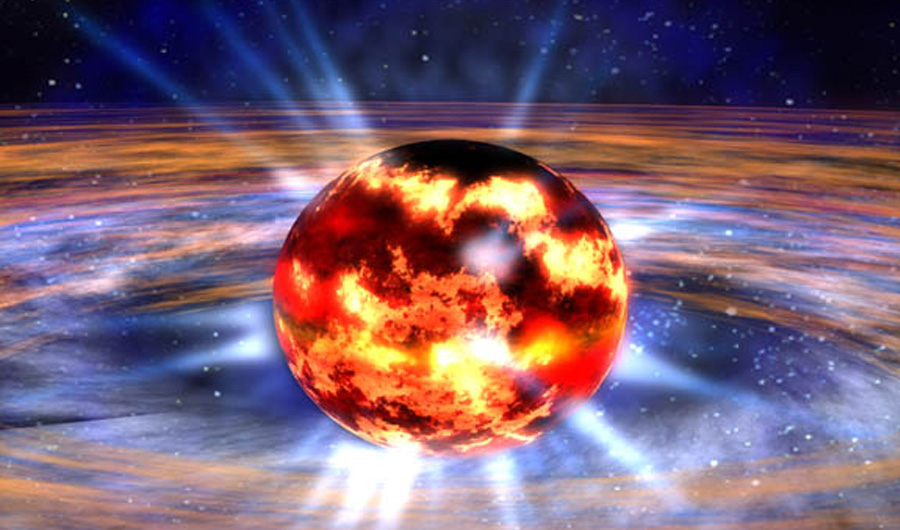Making Gold With Black Holes

(Inside Science) -- The way in which the universe's heaviest elements were forged has long been a mystery. Now some researchers suspect they might have found an answer -- these elements may be born when miniature black holes devour neutron stars from the inside. Such a scenario could also help solve a host of other cosmic puzzles, such as the origin of enigmatic gamma rays and radio bursts.
The universe's three lightest elements -- hydrogen, helium and lithium -- were born in the earliest moments of the cosmos, just a minute or so after the Big Bang. Heavier elements such as iron were forged later by fusing the atomic nuclei of lighter elements with free-roaming protons and neutrons. Such "nucleosynthesis" is generally thought to occur under the extreme temperatures and pressures found either in the hearts of stars or in the cataclysmic, explosive deaths of stars, known as supernovas.
However, "it is a longstanding puzzle where the heavy elements such as gold, platinum and uranium are made," said study co-author Alexander Kusenko, a theoretical physicist at the University of California, Los Angeles. "All we know is that the process involves many neutrons."
The extreme conditions needed to make the heaviest elements could be found in supernovas, but only in rare instances. Current models for nucleosynthesis face challenges explaining the observed abundance of some of the heaviest elements, especially when it comes to the nearby dwarf galaxy Reticulum II, whose stars are unusually rich in such material.
Now researchers suggest the universe's heaviest elements could be forged with the help of black holes born in the early cosmos. Scientists think black holes generally arise when very massive stars die in supernovas and leave behind black holes with roughly the mass of a star. However, nearly 50 years ago, famed physicist Stephen Hawking proposed that much smaller black holes could have formed less than a second after the Big Bang when dense regions of the newborn universe collapsed under their own gravity.
In the new paper, the researchers suggest that these so-called primordial black holes could collide with neutron stars, which are made nearly entirely of neutrons and are so dense that one teaspoon of neutron star would weigh about one billion tonnes. The captured primordial black holes would sink to the centers of the neutron stars and eat them from the inside, causing them to implode. The extreme conditions within these collapsing neutron stars could generate the heaviest elements, and if primordial black holes "are sufficiently numerous, then enough of them could end up in neutron stars to account for all heavy-element production," Kusenko said.
The scientists detailed their findings online August 7 in the journal Physical Review Letters.
If such implosions do happen, they could explain a number of other major puzzles in astronomy as well, said co-author Volodymyr Takhistov, also a theoretical physicist at the University of California, Los Angeles. For instance, the researchers suggest that mysterious gamma rays seen emanating from the Milky Way's core may result from antimatter generated from the radioactive debris of imploding neutron stars. Moreover, the final stages of a neutron star's collapse could generate some of the puzzling, intense outbursts of radio waves discovered roughly a decade ago known as fast radio bursts, which can give off more energy in a second than our sun does in a month.
However, the idea that primordial black holes can implode neutron stars remains "a highly speculative scenario," said theoretical astrophysicist Hans-Thomas Janka at the Max Planck Institute for Astrophysics in Garching, Germany, who did not take part in this research. "We neither know whether primordial black holes exist, nor do we know how many of them fill the space in the centers of galaxies and in dwarf galaxies, nor do we exactly understand how mass could be ejected if such primordial black holes were captured by neutron stars."
Janka noted that future research needs more detailed calculations to see whether neutron stars that have captured black holes can eject significant amounts of mass. Janka also noted that other ways of creating large amounts of the heaviest elements could include mergers between neutron stars, or between neutron stars and stellar-mass black holes.
Joseph Bramante, a theoretical physicist at the Perimeter Institute of Theoretical Physics in Ontario, Canada, said new observations of gravitational waves will help scientists study many different kinds of compact objects in the next few years. Bramante and his colleague Tim Linden at Ohio State University in Columbus have done work that suggests that dark matter particles, if they exist, could also cause neutron stars to implode. Hopefully, the new observations “will reap a lot of rewards when it comes to probing whole classes of particle dark matter and primordial black hole models," Bramante said.

